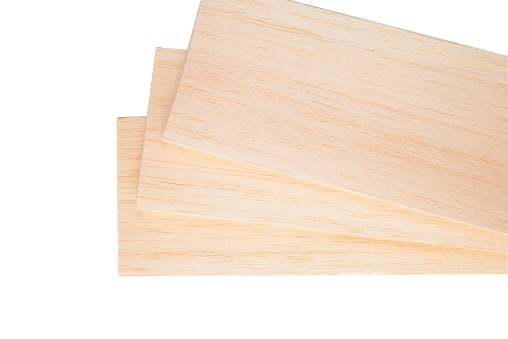Even though balsa is a hardwood, it features broad leaves rather than conifers. As such, it has become famous for being the softest wood that is ideal for many uses. This type of wood is native to countries like Mexico, Bolivia, and Brazil. While it is not considered the strongest, it is easy to work with and cut for building models and design. With a little practice and patience, learning how to cut Balsa wood will allow you to cut just about anything that you can think of out of Balsa wood.
What You Need
- Balsa wood strips
- Stencils/templates
- Geometry tools (rulers, protractors, squares)
- Exacto knife
- Sharp Pencil or Fine-tipped pen
Step-by-Step Instructions
Make Outlines on the Wood

- Put the balsa pieces on a flat work surface. Choose one that can deal with cut marks. A scrap plywood piece or workbench are good options. Balsa wood strips can be secured at a craft or hobby store. They are usually available in sheets that are designed for creating models.
- Use a template or stencil to draw patterns on the wood. There are available templates online that can serve as stencils. Look for one that you are interested in using, printing them out on stiff paper. If you cannot find one that is premade, you can manually draw one. Some pieces may have to intersect if you are planning to create a 3D model. This means the need to cut slots, fitting them together along with the general shapes.
- If you don’t have a pattern, use a ruler or other tools to draw lines. Geometry utensils such as rulers, squares, and protractors will help in creating straight, curved, or angled lines on the wood. Do not forget to create slots and notches if you are interested in fitting things together to create 3D models.
- Mark the lines you have drawn using a sharp pencil or a fine-tipped pen. Trace inside carefully using a pencil or pen, marking your cut lines. Go through the lines a second round to make them stand out on the Balsa wood.
Step 2 – Cut Out the Outlines

- Hold the tip of a utility or craft knife at a 45-degree angle. This will enable the blade to effectively cut wood. As an alternative, a retractable utility knife can also get the job done.
- Start your cuts on a portion of the line that goes across the wood grain. It should be perpendicular, or close to it. Note that Balsa wood is highly delicate and easy to break if you start cutting along the grain.
- Pass the knife through the lines but do not cut through on the first pass. Follow the marked lines, applying light pressure to create a shallow groove. You may use a ruler or other straight edges in guiding your knife through straight cuts. Avoid using a stencil in guiding your cuts, because they are not sturdy enough. All you need is to use stencils in drawing designs.
- End cuts on a portion that is parallel to the grain. Stop at the part of the end line if there is no area where it is parallel to the grain. If you have mostly straight lines, begin with all cuts which are perpendicular to the grain, joining the cuts which are parallel to the grain afterward.
- Continue passing your knife through the lines about two to five times until you are cutting through. Continue this process until you see that the shapes have been cut out from your Balsa wood. The number of passes needed may depend on the thickness of the wood and the amount of pressure applied.
- Make sure that you are careful when cutting balsa. It is much better to allow the knife to pass through the lines several times with less pressure. If you end up becoming impatient and applying too much pressure, which may break the Balsa.
- Finish by sanding the edges of the pieces using 60 or 80 grit sandpaper. This process should be done as carefully as possible. This will ensure that all pieces will fit together easily, looking better when everything is already assembled for building.
Conclusion
Just like other types of woods, Balsa features wood grain. When cutting using an Exacto knife through the pattern line, the grain may lead the knife against the grain. To avoid this, you can simply tilt the blade, cutting from a portion of the line running across the grain to a portion that is in line with the wood grain. In this way, you will be helped to stay on the lines better.
Learning how to cut Balsa wood is very easy when you follow the instructions outlined above. Do you have other thoughts to share? Leave them in the comments section below. Share this article if you like!


Leave a Reply